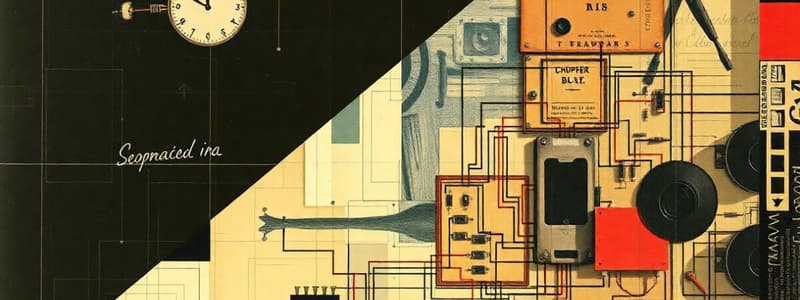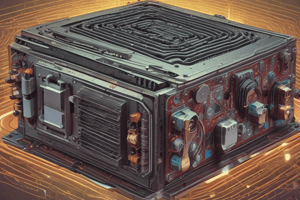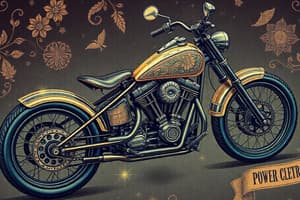Podcast
Questions and Answers
What does the duty cycle 'K' represent in time ratio control?
What does the duty cycle 'K' represent in time ratio control?
- The maximum voltage level achievable
- The total time period of the operation
- The output voltage of the system
- The ratio of ON time to the period (correct)
Which control strategy varies the ON time while keeping frequency constant?
Which control strategy varies the ON time while keeping frequency constant?
- Constant frequency operation (correct)
- Variable frequency operation
- Voltage commutation control
- Current limit control
What occurs during frequency modulation control?
What occurs during frequency modulation control?
- The ON time is kept constant
- The time period 'T' remains unchanged
- Current values are limited to preset levels
- The frequency is altered to adjust voltage (correct)
What is a disadvantage of variable frequency operation?
What is a disadvantage of variable frequency operation?
How does the current limit control strategy maintain constant current?
How does the current limit control strategy maintain constant current?
What does a voltage-commutated chopper primarily utilize for thyristor commutation?
What does a voltage-commutated chopper primarily utilize for thyristor commutation?
Which component is NOT part of the voltage-commutated chopper circuit?
Which component is NOT part of the voltage-commutated chopper circuit?
What must occur for the operation of a voltage-commutated chopper?
What must occur for the operation of a voltage-commutated chopper?
What is the goal of current limit control in a DC-DC converter?
What is the goal of current limit control in a DC-DC converter?
Which term describes the process of turning off a conducting thyristor?
Which term describes the process of turning off a conducting thyristor?
What is the primary function of chopper circuits?
What is the primary function of chopper circuits?
Which of the following describes an AC Link Chopper?
Which of the following describes an AC Link Chopper?
Why are chopper circuits necessary?
Why are chopper circuits necessary?
What makes DC Choppers more efficient than AC Link Choppers?
What makes DC Choppers more efficient than AC Link Choppers?
Which of the following control strategies is NOT employed in DC choppers?
Which of the following control strategies is NOT employed in DC choppers?
Chopper circuits can be considered as:
Chopper circuits can be considered as:
What happens to the output voltage in a DC chopper?
What happens to the output voltage in a DC chopper?
What are the disadvantages of AC Link Choppers?
What are the disadvantages of AC Link Choppers?
Which of the following is true regarding the need for DC to DC conversion?
Which of the following is true regarding the need for DC to DC conversion?
What type of input does a chopper circuit primarily work with?
What type of input does a chopper circuit primarily work with?
What happens to the charging current once the thyristor TM is triggered in the voltage commutated chopper circuit?
What happens to the charging current once the thyristor TM is triggered in the voltage commutated chopper circuit?
How does the load voltage change when the capacitor discharges through the load in a voltage commutated chopper?
How does the load voltage change when the capacitor discharges through the load in a voltage commutated chopper?
What is the role of the diode D in the voltage commutated chopper circuit?
What is the role of the diode D in the voltage commutated chopper circuit?
What occurs when the auxiliary thyristor TA is triggered in the system?
What occurs when the auxiliary thyristor TA is triggered in the system?
Which chopper type is designed to increase the output voltage?
Which chopper type is designed to increase the output voltage?
When the voltage across the capacitor becomes zero, which condition exists in the voltage commutated chopper?
When the voltage across the capacitor becomes zero, which condition exists in the voltage commutated chopper?
What does a step-down chopper primarily achieve in a circuit?
What does a step-down chopper primarily achieve in a circuit?
Which of the following is true about the operation of an AC chopper?
Which of the following is true about the operation of an AC chopper?
What defines the behavior of a voltage commutated chopper when the capacitor begins to charge again?
What defines the behavior of a voltage commutated chopper when the capacitor begins to charge again?
In what scenario is the Jones chopper mentioned?
In what scenario is the Jones chopper mentioned?
What occurs after the thyristor TM is triggered in the voltage commutated chopper?
What occurs after the thyristor TM is triggered in the voltage commutated chopper?
How does the load voltage behave when the capacitor is discharged through the load?
How does the load voltage behave when the capacitor is discharged through the load?
What is the role of the auxiliary thyristor TA during the operation of the voltage commutated chopper?
What is the role of the auxiliary thyristor TA during the operation of the voltage commutated chopper?
What does the diode D do when the voltage across the capacitor is reversed?
What does the diode D do when the voltage across the capacitor is reversed?
What happens to the charging current when the capacitor voltage is equal to the supply input voltage?
What happens to the charging current when the capacitor voltage is equal to the supply input voltage?
When does the process of reverse charging begin in the voltage commutated chopper?
When does the process of reverse charging begin in the voltage commutated chopper?
What is the impact of overcharging the capacitor in the chopper circuit?
What is the impact of overcharging the capacitor in the chopper circuit?
Which component is essential to maintain the oscillatory circuit in the voltage commutated chopper?
Which component is essential to maintain the oscillatory circuit in the voltage commutated chopper?
What defines a step-up chopper in comparison to other types?
What defines a step-up chopper in comparison to other types?
What regulates the power flow within an AC chopper?
What regulates the power flow within an AC chopper?
What is the primary characteristic of variable frequency operation in time ratio control?
What is the primary characteristic of variable frequency operation in time ratio control?
What is a notable disadvantage of the frequency modulation (FM) method in control strategy?
What is a notable disadvantage of the frequency modulation (FM) method in control strategy?
How does the current limit control strategy operate during a DC to DC conversion?
How does the current limit control strategy operate during a DC to DC conversion?
What type of thyristor commutation does a voltage-commutated chopper use?
What type of thyristor commutation does a voltage-commutated chopper use?
What is a necessary condition for the operation of a voltage-commutated chopper?
What is a necessary condition for the operation of a voltage-commutated chopper?
In what scenario does the current freewheel through the diode during current limit control?
In what scenario does the current freewheel through the diode during current limit control?
Which control strategy is typically preferred for choppers or DC-DC converters?
Which control strategy is typically preferred for choppers or DC-DC converters?
What is the main function of extra elements in forced commutation?
What is the main function of extra elements in forced commutation?
What defines the behavior of a thyristor in a high power circuit when using a voltage-commutated chopper?
What defines the behavior of a thyristor in a high power circuit when using a voltage-commutated chopper?
What is the primary purpose of a chopper circuit in electricity conversion?
What is the primary purpose of a chopper circuit in electricity conversion?
What is a primary reason for the need for chopper circuits?
What is a primary reason for the need for chopper circuits?
What distinguishes the DC chopper from the AC link chopper?
What distinguishes the DC chopper from the AC link chopper?
Which of the following statements is true regarding time ratio control in DC choppers?
Which of the following statements is true regarding time ratio control in DC choppers?
What is a characteristic of the AC link chopper process?
What is a characteristic of the AC link chopper process?
Which of the following is NOT a control strategy used in DC choppers?
Which of the following is NOT a control strategy used in DC choppers?
What aspect of a chopper circuit allows it to behave like an AC transformer?
What aspect of a chopper circuit allows it to behave like an AC transformer?
What can be said about the efficiency of AC link choppers compared to DC choppers?
What can be said about the efficiency of AC link choppers compared to DC choppers?
What is the main action occurring during current limit control in a DC chopper?
What is the main action occurring during current limit control in a DC chopper?
What is a drawback of using AC link choppers?
What is a drawback of using AC link choppers?
What defines the behavior of a DC chopper in terms of its output voltage?
What defines the behavior of a DC chopper in terms of its output voltage?
Flashcards
Chopper Circuit
Chopper Circuit
A circuit that converts a fixed DC voltage into an adjustable DC voltage.
DC to DC Converter
DC to DC Converter
Another name for a chopper circuit.
AC Link Chopper
AC Link Chopper
A two-stage DC-to-DC converter that first converts DC to AC, then AC back to DC using a transformer.
DC Chopper
DC Chopper
Signup and view all the flashcards
Time Ratio Control
Time Ratio Control
Signup and view all the flashcards
Current Limit Control
Current Limit Control
Signup and view all the flashcards
Static Power Electronics Device
Static Power Electronics Device
Signup and view all the flashcards
Need for DC-to-DC conversion
Need for DC-to-DC conversion
Signup and view all the flashcards
DC equivalent to AC transformer
DC equivalent to AC transformer
Signup and view all the flashcards
Two-stage conversion
Two-stage conversion
Signup and view all the flashcards
Voltage Commutated Chopper
Voltage Commutated Chopper
Signup and view all the flashcards
Time Ratio Control
Time Ratio Control
Signup and view all the flashcards
Charging a Capacitor
Charging a Capacitor
Signup and view all the flashcards
Constant Frequency Operation
Constant Frequency Operation
Signup and view all the flashcards
Variable Frequency Operation
Variable Frequency Operation
Signup and view all the flashcards
Load Current (i0)
Load Current (i0)
Signup and view all the flashcards
Current Limit Control
Current Limit Control
Signup and view all the flashcards
Commutation Current (ic)
Commutation Current (ic)
Signup and view all the flashcards
Voltage-Commutated Chopper
Voltage-Commutated Chopper
Signup and view all the flashcards
Step-up Chopper
Step-up Chopper
Signup and view all the flashcards
Step-down Chopper
Step-down Chopper
Signup and view all the flashcards
Commutation
Commutation
Signup and view all the flashcards
Forced Commutation
Forced Commutation
Signup and view all the flashcards
AC Chopper
AC Chopper
Signup and view all the flashcards
Jones Chopper
Jones Chopper
Signup and view all the flashcards
Voltage Commutation
Voltage Commutation
Signup and view all the flashcards
Auxiliary Thyristor (TA)
Auxiliary Thyristor (TA)
Signup and view all the flashcards
Load Commutation
Load Commutation
Signup and view all the flashcards
Charging process polarity
Charging process polarity
Signup and view all the flashcards
DC-DC converter applications
DC-DC converter applications
Signup and view all the flashcards
Chopper Circuit
Chopper Circuit
Signup and view all the flashcards
AC Link Chopper
AC Link Chopper
Signup and view all the flashcards
DC Chopper
DC Chopper
Signup and view all the flashcards
Time Ratio Control
Time Ratio Control
Signup and view all the flashcards
Current Limit Control
Current Limit Control
Signup and view all the flashcards
Need for DC-to-DC conversion
Need for DC-to-DC conversion
Signup and view all the flashcards
DC equivalent to AC transformer
DC equivalent to AC transformer
Signup and view all the flashcards
Two-stage conversion
Two-stage conversion
Signup and view all the flashcards
Single-stage conversion
Single-stage conversion
Signup and view all the flashcards
Time ratio control
Time ratio control
Signup and view all the flashcards
Time Ratio Control
Time Ratio Control
Signup and view all the flashcards
Constant Frequency Operation
Constant Frequency Operation
Signup and view all the flashcards
Variable Frequency Operation
Variable Frequency Operation
Signup and view all the flashcards
Current Limit Control
Current Limit Control
Signup and view all the flashcards
Voltage-Commutated Chopper
Voltage-Commutated Chopper
Signup and view all the flashcards
Commutation
Commutation
Signup and view all the flashcards
Forced Commutation
Forced Commutation
Signup and view all the flashcards
Load Commutation
Load Commutation
Signup and view all the flashcards
Auxiliary Thyristor (TA)
Auxiliary Thyristor (TA)
Signup and view all the flashcards
DC-DC Converter Applications
DC-DC Converter Applications
Signup and view all the flashcards
Voltage Commutation
Voltage Commutation
Signup and view all the flashcards
Step-up Chopper
Step-up Chopper
Signup and view all the flashcards
Step-down Chopper
Step-down Chopper
Signup and view all the flashcards
Commutation Current (ic)
Commutation Current (ic)
Signup and view all the flashcards
Load Current (i0)
Load Current (i0)
Signup and view all the flashcards
Auxiliary Thyristor (TA)
Auxiliary Thyristor (TA)
Signup and view all the flashcards
Charging a Capacitor
Charging a Capacitor
Signup and view all the flashcards
Voltage-Commutated Chopper
Voltage-Commutated Chopper
Signup and view all the flashcards
AC Chopper
AC Chopper
Signup and view all the flashcards
Charging process polarity
Charging process polarity
Signup and view all the flashcards





